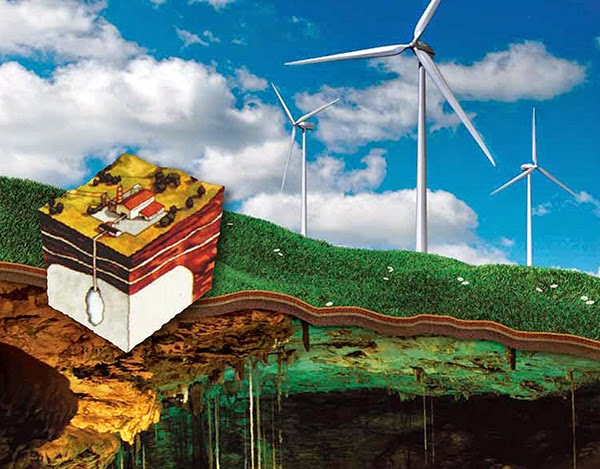 [Image: From a PDF by Dresser Rand].
[Image: From a PDF by Dresser Rand].
A new electricity distribution system being described as the “‘Hoover Dam’ of the 21st century” will bring wind energy from Wyoming to customers in California—and it will get there by way of a $1.5 billion artificial cave built specifically for storing air inside a salt dome in Utah.
The particular geologic site chosen for this underground storage facility is “a five-mile long, two-mile deep salt deposit,” the Casper Star Tribune reports. “Electricity there would be used to compress air into four underground caverns hallowed [sic] out of the salt deposit. During times of high-demand, air would be released, turning a turbine to create electricity.”
It’s a kind of clockwork weather system buried inside the earth, like something out of the Aeneid.
Dresser Rand, the firm behind the new storage facility, describes a related complex they worked on in Alabama. In a PDF available on their website, they write that their technology allows them to “store air in a salt dome at pressures up to 1100 psig.” To create that facility, the Alabama plant manager explains, “we solution mined it for 629 days. That created 19 million cubic feet of cavern storage.” That’s roughly half an Empire State Building of empty space.
Solution mining works by injecting brine down into salt formations, which dissolves the salt; the brine is then pumped back up to the surface, leaving behind huge empty spaces—artificial caves—usually shaped a bit like lightbulbs or distorted spheres.
In fact, the process brings to mind the extraordinary spatial creations known as “sewage bulbs,” melted directly into the glaciers of Antarctica, as described by William L. Fox in his book Terra Antarctica:
Water for the station is derived by inserting a heating element—which looks like a brass plumb bob 12 feet in diameter—150 feet into the ice and then pumping out the meltwater. After a sphere has been hollowed out over several years, creating a bulb that bottoms out 500 feet below the surface, they move to a new area, using the old bulb to store up to a million gallons of sewage, which freezes in place—sort of. The catch is, the ice cap is moving northward toward the coast (and Rio de Janeiro) at a rate of about an inch a day, or 33 feet per year. That movement means that the tunnels are steadily compressing; as a result, they have to be reamed out every few years to maintain room for the insulated water and sewage pipes. Because each sewage bulb fills up in five to six years, they’re hoping—based on the length of the tunnel and the number of bulbs they can create off it (perhaps even seven or eight)—this project will have a forty-year lifespan. Ultimately, in about the year A.D. 120,000, the whole mess should drop off into the ocean.
In any case, these artificial caves in Utah—let’s call them “wind bulbs”—will thus be linked up with California’s electrical grid, forming a partially subterranean interstate megastructure for on-demand renewable energy transmission.
As the Casper Star Tribune points out, the entire system—this so-called “Hoover Dam of the 21st century,” with a total price tag pushing $8 billion—could someday power as many as 1.2 million California homes and it could be operational as early as 2023.
(Originally spotted via @jonnypeace).

Anyone that thinks this is a neat achievement (for it is neat indeed) shouldn't turn around and repeat false and stupid things about hydraulic fracturing causing terrible earthquakes, and the like.
The explosion (a fair word to use here, even though it's not the direct result of a combustion process) that would result from 1.9e^7 cubic feet of air at 1100 psi suddenly escaping the chamber would be big. I'd much rather live next door to a conventional coal or nuclear power plant than any kind of compressed air scheme such as this.
That was the first thing I thought of as well, but the engineering and monitoring would prevent an explosion from ever happening. The thing is, hydro fracturing is poisoning our land and water. The pollution released when it burns contaminates communities and contributes to more pollution and acid rain. The related social costs of cleanup and health care makes fossil fuels way more dangerous.